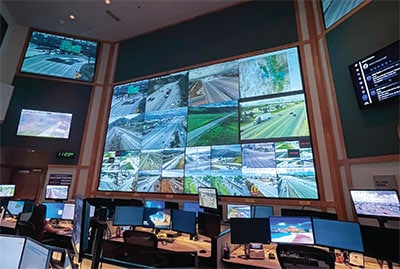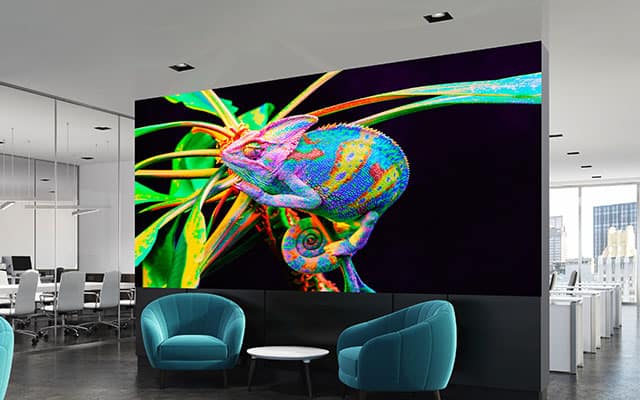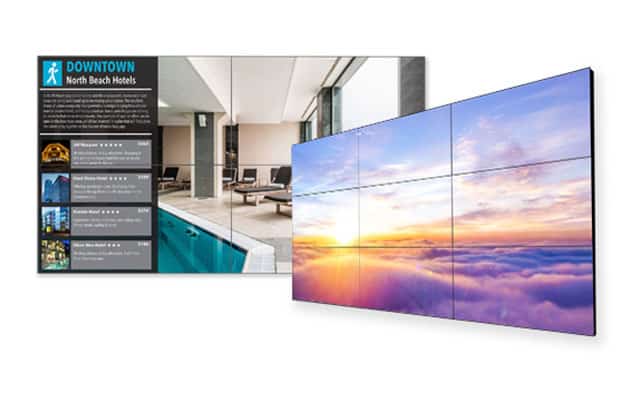Choosing the right display solution for your needs can be a daunting task. In this blog, we will delve into the basics of LCD (Liquid Crystal Display) technology and provide an overview of dView (Direct View LED) technology. If you are a business owner, building manager or the computer guy considering digital display solutions, this guide will help you navigate the world of display technologies and choose the right solution for your specific requirements. So, let’s dive in and explore the world of LCD and dView technologies.
Table of Contents
Understanding LCD and dView Technologies: The Basics
LCD and dView technologies are two popular options for indoor video wall displays. Each technology offers unique advantages and is better suited for specific use applications.
LCD technology offers exceptional color accuracy and image quality, making it ideal for applications such as control rooms, retail environments, and corporate meeting spaces, where precision and clarity are paramount. LCD screens are thinner, lighter, and more energy efficient than traditional CRT displays. They also produce less heat, making them more comfortable to use in prolonged periods. LCD screens use a backlighting system, typically consisting of a white LED light source, to illuminate the liquid crystals and create the images on the screen.
On the other hand, dView technology, also known as Direct View LED technology, is specifically designed for outdoor and large-scale displays. dView technology utilizes individual red, blue, white, and green LED lights to create vibrant and immersive visuals. These LED lights are capable of emitting high levels of brightness, ensuring visibility even in bright outdoor settings. dView displays are energy efficient and offer seamless integration, making them suitable for applications such as outdoor advertising, concerts and festivals, and sports arenas and stadiums.
When choosing between LCD and dView technology, it is important to consider the specific use scenario and requirements of the display. LCD technology excels in indoor environments where color accuracy and image quality are crucial. On the other hand, dView technology is better suited for outdoor settings and large-scale displays where high brightness and seamless integration are important factors.
Advantages of LCD Technology:
- Exceptional Image Quality: LCD displays provide high-resolution images with exceptional color accuracy and clarity, making them ideal for applications that require precise image rendering.
- Wide Viewing Angles: LCD panels offer wide viewing angles, ensuring that the content is visible from various positions without any loss in image quality.
- Energy Efficiency: LCD technology is known for its energy efficiency, consuming less power compared to other display technologies.
- Thin and Lightweight Design: LCD panels are thinner and lighter than other display technologies, making them easy to install and integrate into various indoor settings.
- Cost-Effective: LCD video walls are generally more affordable compared to other display technologies, making them a cost-effective option for businesses and organizations.
Common Use Scenarios for LCD Wall Displays

It’s probably best to think about LCD wall displays as televisions or computer monitors. Keep in mind that there may be situations where you want larger displays than are available in a single panel. If that’s the case, you can combine panels to effectively make a giant LCD display.
LCDs also produce brighter images due to the backlighting that makes them work, meaning they’re often a better fit in extremely bright areas where you don’t have so much direct control over area lighting.
Commercial rated LCDs do offer 16/7 operation cycles for many years, but they should probably be replaced every 5-7 years as a part of your technology lifecycle management.
- Control Rooms: LCD video walls are preferred in control rooms where precise image rendering and color accuracy are crucial for monitoring and decision-making.
- Conference Rooms: LCD video walls are suitable for conference rooms where image quality and clarity are important for presentations and collaborations.
- Command Centers: LCD video walls are commonly used in command centers where real-time information needs to be displayed with high precision and accuracy.
Advantages of dView Technology:
dView displays are generally best where you want visuals throughout an extremely large space. They are capable of displaying a dark black, which is desirable in low and controlled light situations. LED video walls are commonly used in outdoor advertising, concerts, festivals, and sports events due to their vibrant displays and durability.
Their excellent longevity tends to support longer term installations. They are usually treated as a long-term building improvement.
Advantages of dView Technology:
- High Brightness: LED displays utilize LED lights to produce vibrant and bright visuals, making them suitable for applications that require high brightness and visibility, such as outdoor installations and large-scale events.
- Seamless Integration: dView panels seamlessly integrate to create a larger display surface without visible bezels, providing a more immersive viewing experience.
- Energy Efficiency: While LED technology consumes more power compared to LCD, dView displays are designed to be energy-efficient, utilizing low-voltage LED lights.
- Long Lifespan: LED lights have a longer lifespan compared to traditional light sources, reducing maintenance and replacement costs.
- Flexibility in Design: dView displays offer flexibility in design and can be customized to fit specific requirements, allowing for creative and unique video wall installations.
Common Use Scenarios:

- Retail Spaces: dView displays are popular in retail spaces as they provide high brightness and vibrant visuals, attracting customers and enhancing the shopping experience.
- Trade Shows and Events: dView displays create a lasting impression at trade shows and events with their bright and seamless visuals, drawing visitors to booths.
- Concert Venues and Sports Arenas: dView displays can be easily seen and display beautiful video productions, exciting event attendees.
Comparing LCD vs dView Technologies
| Feature | LCD | dView |
| Image quality | LCDs have high resolution and sharp images, but they may suffer from motion blur, low contrast ratio, and color distortion. | dViews have lower resolution and less sharp images, but they have better motion handling, high contrast ratio, and wide color gamut. |
| Viewing angle | LCDs have narrow viewing angles, which means the image quality deteriorates when viewed from the sides or above or below. | dViews have wide viewing angles, which means the image quality remains consistent from any direction. |
| Energy efficiency | LCDs consume more power than dViews, especially when displaying bright images or white backgrounds. | dViews consume less power than LCDs, especially when displaying dark images or black backgrounds. |
| Brightness | LCDs have high brightness levels, which makes them suitable for bright environments or outdoor use. | dViews have lower brightness levels, which makes them more suitable for dark environments or indoor use. |
| Contrast | LCDs work via a backlight that illuminates the liquid crystal. This tends to wash out blacks and emphasize light colors. | dViews use self-emitting pixels, meaning blacks are truly areas without light coming from them. |
| Lifespan | LCDs have longer lifespan than dViews, as they are less prone to burn-in, image retention, or degradation. | dViews have shorter lifespan than LCDs, as they are more prone to burn-in, image retention, or degradation. |
| Size and weight of displays | LCDs are thinner and lighter than dViews, which makes them easier to mount or carry. | dViews are thicker and heavier than LCDs, which makes them harder to mount or carry. |
| Design flexibility | LCDs have less design flexibility than dViews, as they require a backlight and a rigid glass substrate. | dViews have more design flexibility than LCDs, as they do not require a backlight and can be made on flexible plastic substrates. |
| Cost | LCDs are cheaper than dViews, as they are more mature and widely available. | dViews are more expensive than LCDs, as they are newer and less available. |
A More Detailed Look at Display Technology
The History of LCD and dView
Display technology has come a long way since its invention in 1888 by Friedrich Reinitzer. The first experimental liquid crystal display was developed by the RCA Corporation in 1968, and since then, the technology has undergone significant developments and advancements. LCD technology draws its name from the liquid crystals used in its display. These liquid crystals change their orientation in response to an electric current, allowing light to pass through or be blocked, creating images on the screen.
LCD technology offers excellent color accuracy and image quality, making it suitable for indoor environments like control rooms, boardrooms, and retail spaces. It provides superior image quality and color accuracy, making it suitable for applications that require precise rendering of images, such as control rooms and retail environments.
Use Cases
Both LCD and dView technologies have their advantages and are used in various industries based on their specific requirements. LCD technology provides superior image quality and color accuracy, making it suitable for applications that require precise rendering of images, such as control rooms and retail environments. On the other hand, dView technology, such as LED video walls, offers high brightness, energy efficiency, and the ability to create seamless and vibrant displays, making it ideal for outdoor advertising and large-scale events.
When considering which technology to use, factors such as the environment, lighting conditions, and specific application requirements should be taken into account. Both LCD and dView technologies have seen continuous advancements, with LCD technology offering narrow bezel options for seamless displays and dView technology incorporating innovative designs and mounting techniques.
Don’t Forget Video Wall Software
To ensure efficient message delivery and optimization of indoor video wall design principles, it is essential to utilize advanced content management software. This software allows you to schedule and update content effortlessly, tailoring your messages to specific times and events. By utilizing content scheduling strategies, you can maximize the impact of your indoor video wall and effectively engage your audience.
Video wall software plays a crucial role in managing and optimizing video wall displays, enabling content scheduling, monitoring, and remote control. It allows for the seamless management and control of content, ensuring a fluid viewing experience. The software also enables real-time updates and smooth transitions between different sources, delivering a seamless viewing experience.
Industry Use: Retail, Public Events, Education and Control Rooms
Video walls have transformed various industries, including retail, events, education, control rooms, and security, by providing immersive and engaging visual experiences. In the retail sector, video walls are utilized to attract customers and enhance their shopping experiences. They offer eye-catching displays of products, promotions, and brand messages, effectively driving sales and brand engagement.
Educational institutions utilize video walls to create interactive and immersive learning environments. These walls enable educators to present complex concepts, engage students, and encourage collaboration.
Mission-critical environments, such as control rooms and security centers, rely on video walls to monitor various data feeds simultaneously. The large displays allow operators to quickly assess situations and make informed decisions in real-time.
The Video Wall Industry
Video wall technologies have emerged as game-changers, captivating audiences and transforming the way information is presented. As the demand for captivating visual displays grows, businesses seek video wall solutions that combine cutting-edge technology with seamless performance. From corporate boardrooms to large-scale events, video walls are revolutionizing various industries, empowering users to harness their full potential.
The video wall industry has witnessed remarkable trends in 2023, with a focus on innovative video wall designs that incorporate narrow bezels for a seamless viewing experience. The video wall setup for conferences has become increasingly popular, enabling speakers to captivate attendees with impactful visuals.
For those exploring video wall options, the search for cost-effective solutions ends with LED video walls. Not only do they offer enhanced visual quality, but they also provide long-term savings through lower maintenance costs. Additionally, video wall management software has come a long way, making it easier to control and organize content across video walls of various sizes.
Understanding the need for reliability and adaptability, video walls have found applications in diverse settings, such as surveillance, digital signage, and control rooms. Moreover, businesses can benefit from video wall rental services, making it feasible to utilize this powerful technology for specific events without the burden of ownership.
The fundamental differences between LCD and dView displays
The fundamental differences between LCD and dView displays have been explored, highlighting the technology behind each display type and their respective benefits and drawbacks. Now, let’s delve deeper into the capabilities and applications of these display technologies.
LCD displays have been widely used in various electronic devices due to their ability to produce clear and vibrant images. These displays utilize a layer of liquid crystal sandwiched between two transparent electrodes. By applying an electric current to specific areas of the liquid crystal layer, the alignment of its molecules can be altered, which affects the display’s reflectivity or transmission of polarized light. However, LCD displays do not emit light directly and require a backlight or reflector to produce images. This backlight or reflector can be used to create images in color or monochrome.
LCD displays also come in two different variations: positive LCD and negative LCD. Positive LCD displays feature dark-colored or black characters or symbols on a light-colored background, making them suitable for applications where high contrast is desired. On the other hand, negative LCD displays feature light-colored characters or symbols on a dark-colored background, which can be more visually appealing in certain situations.
Choosing Proper Resolution for your Video Wall is Imperative
When selecting LCD displays for your application, it is important to consider factors such as resolution, size, and aspect ratio. The resolution of a display determines the sharpness of the images and text displayed. Higher resolutions, such as Full HD (1920×1080) and 4K (3840×2160), result in sharper and more detailed visuals. The size of the display panels should align with the available space and viewing distance to maintain optimal visual impact. Additionally, the aspect ratio of the display panels should match the desired proportions of the content being displayed.
The Cost of Creating a Video Wall
The cost of video walls can vary based on factors such as the overall display size, pixel density, shape of design, requirements for video processing, indoor or outdoor application, and complexity of installation and setup. On average, a video wall system can cost between $50,000 and $350,000, depending on the project. LED wall panels, which are commonly used in video walls, can cost between $1,000 and $3,000 per panel, with an average size of 500 x 500 mm. Processors and software costs can also vary based on the desired level of customization and functionality.
Some of the top brands for video wall displays include Samsung, LG, Sony, and Sharp. These brands offer a wide range of options and choices for different needs and budgets.
Setting up a video wall involves determining the location, size, and shape of the display, the desired interaction with employees, audience, or the public, the type of content to be displayed, the size and aspect ratio, and the features desired. It also requires selecting the appropriate screens and system to use. While the process may seem complex, video walls are not difficult to set up or use. They can be easily controlled with a single interface, making them user-friendly for both technology enthusiasts and professionals in the AV industry.
Conclusion
After exploring the differences between LCD and dView technologies, it’s clear that both display solutions have their own unique advantages and applications. LCD displays offer excellent image quality, wide viewing angles, and are well-suited for indoor environments. On the other hand, dView displays provide superior brightness, contrast, and durability, making them ideal for outdoor and large-scale applications. When choosing the right display solution, it’s crucial to consider factors such as the intended use, environment, budget, and specific requirements. By understanding the basics of LCD and dView technologies, you can make an informed decision and invest in a display solution that meets your needs and enhances your visual experience. So, whether you’re looking to upgrade your digital signage, set up a video wall, or incorporate displays into your business operations, take the time to evaluate your options and choose the display technology that will take your visuals to the next level. Happy display shopping!
Sources:
[PDF] Virtual Environments: A Survey of the Technology
LCD Display construction and its working – ElProCus
2024 Heat n sweep – Giovanna Ray
Digital Panel Meters – Differences Between LCD and LED Displays
What are the advantages of LCD screens compared to other display …

